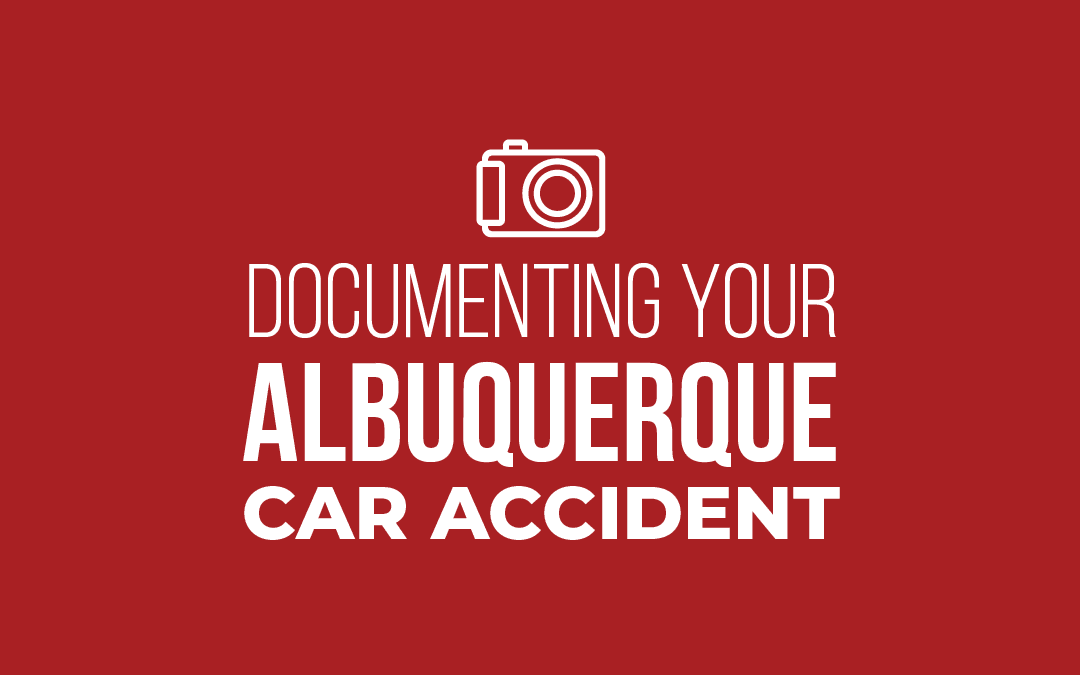What To Do At The Scene Of An Accident

Following a car crash, as you process the events that occurred and adrenalin kicks in, remembering to document the scene likely won’t be the first thing to come to your mind. In the chaos of a collision, details can be missed, and evidence can be overlooked. While responding officers will document the scene in their accident report, this documentation is sometimes lacking. Having adequate photos of the accident scene and images of the aftermath and your healing process is crucial for your personal injury claim. Even in a minor car accident, it’s important to make sure proper steps are followed.
As an Albuquerque firm that has advocated for our car accident clients for over 40 years, Ron Bell Injury Lawyers understands the power of well-documented evidence. In this guide, we’ll discuss the types of photos that will help build your credibility and the strength of your case. We’ll also offer tips on taking effective photos of your collision and best practices when documenting your injuries, both at the scene of the collision and as you begin your medical treatment journey.
If you’ve been injured in a wreck that wasn’t your fault, an experienced Albuquerque car accident lawyer from our firm can help you recover every dollar you deserve from the insurance company. Call us today for a free consultation at 505-898-2355.
The Scene of the Accident: A Pivotal Moment for Documentation
The accident scene tells an important story. It shows how the collision occurred, provides context for any factors that may have contributed to the crash, and demonstrates the severity of the wreck. Here are a few things you should photograph at the scene following an Albuquerque car accident:
The Overall Scene: Begin by taking wide-angle shots that capture the entire car accident scene, including the positioning of all vehicles involved, traffic signals, and street signs. If the road conditions may have played a part in the collision (such as the presence of potholes, a lack of guard rails, etc.), be sure to capture that in the photo as well. These photos provide helpful context and can show how the accident occurred, aiding investigators and attorneys in determining fault.
Vehicle Damage: Capture detailed images of any damage to your vehicle as well as any other vehicles involved. Take photos from various angles to showcase the extent of the impact, and can help prove fault based on the location of the damage. Close-ups of specific damage, such as dents, scratches, or deployed airbags, can be instrumental in assessing the force of the collision and to help prove injuries that may not be noticeable immediately. For example, whiplash claims can often be supported by how a vehicle was struck and where the impact took place.
Tire Marks and Debris: Tire marks or skid marks can show how a vehicle tried (or failed) to avoid causing an accident. They can also help determine how fast cars were traveling at the time of impact. Similarly, debris from the wreck and the distance it is found from the collision scene can show the severity of the impact. Be sure to document both pieces of evidence to strengthen your case.
Weather and Lighting Conditions: Note the weather conditions at the time of the accident. If factors such as pooled water, ice, or snow played a role in the crash, make sure they are photographed. Take pictures of the scene under the same lighting conditions as the accident, if possible, as this can affect visibility and perception.
Witness/Vehicle Information: If there are witnesses at the scene, document their contact information. Witness statements and testimonies can play a pivotal role in establishing the sequence of events leading up to the accident. Take photos of the license plates of any vehicles involved as well if you’re able. This documentation will make piecing together the narrative and contacting those involved in the event easier in the days ahead.
Injuries: If you’ve been seriously hurt, you may not be able to take photos of your injuries, and some injuries, including whiplash, may not be visible. However, it’s important to remember that some injuries, such as cuts and bruises, can fade over time. Documenting these injuries as soon as possible (as well as seeking medical treatment) is vital for your case. If you’re able, take photos of these injuries as soon as possible, or have someone else take photos of them for you.
Aftermath and Healing: Photos of your injuries at the scene of the accident show the immediate effects; photos after the accident and throughout your medical treatment show the lasting impacts. Some accident victims may have to undergo surgery or rehabilitation following a collision. Images of incisions, staples, or scarring resulting from surgery or medical intervention show how the car crash continued to influence your everyday life long after you left the scene.
Using Video: Some injuries are better demonstrated with video evidence rather than through photos. In cases of severe injuries that impact mobility, video can be an especially powerful tool. For instance, if your injuries have caused you to be unable to walk without the assistance of a cane, a video can be used to show how the collision has changed your gait and posture. Those who must undergo extensive physical rehabilitation, either for a physical injury or a traumatic brain injury (TBI), may experience limited mobility in their hands or legs. Video evidence of physical limitations such as these is a strong piece of documentation when negotiating with the insurance company.
Best Practices for Capturing Compelling Photos and Videos
The quality and content of the photos and videos you capture at the scene of a car accident can make a significant difference in the strength of your personal injury case. However, that doesn’t mean you need a powerful camera or sophisticated equipment to document the accident scene or your injuries. A smartphone is more than capable of taking the necessary photos and videos you need to build your case.
In the digital age, photo storage is rarely an issue. Remember, you only have one opportunity to capture the immediate aftermath of the accident. Take plenty of photos to ensure you have options and variations in your imagery. Your legal team can help determine which pictures are helpful and which ones can be discarded later. Remember to take photos from multiple angles and distances, including wide-angle images that capture the entire scene and close-up shots that show details of the collision.
Clarity is key when taking pictures of your Albuquerque car accident scene. A blurry photo that doesn’t clearly show the subject does little to build your case. You can avoid blurry photos by holding your camera steady. You don’t need a tripod to do this – simply prop your arm against something stable, such as your vehicle or a guardrail, to keep your hands from shaking. You can also reduce blurriness in a photo by making sure you have adequate light. This can be difficult if you find yourself at an accident scene on a rural or poorly lit road. If you’re in a dark setting, consider using a flashlight or the flash on your phone to illuminate the scene better.
To further solidify the evidence you collect, you may wish to explore including digital information within your photos. Many phones will allow you to include location and time stamp data – information that conveys the date, time, and location of where the photo was taken. While this information won’t be visible in the photographs you take, it will be retrievable within the data of the image itself. This information adds an additional layer of credibility to your photos and provides an irrefutable timeline of events.
The Benefit of Photos and Videos in Your Injury Claim
Photos and videos are used to construct a visual narrative for your case. They can be used to confirm or refute the negligent party’s claims, determine fault in the collision, and provide tangible evidence of wrongdoing. They also provide a visual aid that adds power and leverage when negotiating with the insurance company or arguing your case in court. While medical records and other documentation will build the logical strength of your case, photos and videos appeal to emotion. Words can describe the extent of injuries, but being able to show an insurance adjuster or a jury visual evidence of a car crash and the injuries that arise from it can sometimes prove more impactful.
Call our legal team now for a free consultation
Call 898-BELL
Ring the Bell!
In the aftermath of a car accident, the actions you take in the first moments and days can determine the trajectory of your personal injury case. Through meticulous documentation of the accident scene and ongoing documentation of your injuries, you can begin building a stronger case at the onset of your claim. However, the evidence you collect through photos and video is only one piece of your personal injury case. Knowing how to use the evidence you’ve collected when negotiating with the insurance company is just as important as the photos and videos themselves. An Albuquerque car accident lawyer knows how to best utilize the documentation you collect and make it work in favor of your personal injury claim.
By hiring an experienced attorney at Ron Bell Injury Lawyers, you’ll have a team of legal professionals in your corner who can help you sort through your photos and videos, determine which ones will have the most impact on your claim, and advocate for the highest amount of compensation available to you. You don’t have to face the insurance company alone! Contact us today at 898-BELL for a free, no-obligation consultation.
Why Choose Ron Bell Injury Lawyers?
We Get Results!
